西戈約特組
外觀
| 西戈約特組 地層年代:馬斯垂克期 ~ | |
|---|---|
 西戈約特組賀明察夫(Hermiin Tsav)地區 | |
| 類型 | 層 |
| 上覆 | 耐梅蓋特組 |
| 下伏 | 德加多克塔組 |
| 厚度 | 110米(360呎) |
| 岩性 | |
| 主要 | 砂岩 |
| 地點 | |
| 經緯度 | 43°30′N 99°48′E / 43.5°N 99.8°E |
| 地區 | 南戈壁省 |
| 國家 | |
| 範圍 | 戈壁 |
| [[file:|frameless|alt=]] | |
西戈約特組(英文:Barun Goyot Formation、West Goyot Formation)是地層年代屬白堊紀晚期的地層組,位於蒙古國南戈壁省的戈壁沙漠盆地。
描述
[編輯]
西戈約特組早先被稱為是下耐梅蓋特組,位於耐梅蓋特組之下,德加多克塔組之上。但也有科學家認為西戈約特組與德加多克塔組屬於相同的岩性單位,兩者之間並無明確的分界。西戈約特組的層型為位於耐梅蓋特地區東側的胡山地區。而在耐梅蓋特地區,僅可見西戈約特化石層的最上層部分。另外,克明察夫地區的紅化石層也被認為屬於西戈約特組。西戈約特組的地層厚度約為110米(360呎)[1],地層年代約為7,000至7,100萬年前的馬斯垂克期早期,當時主要的環境組成是由岩石風蝕所形成的沙丘。
古生物群
[編輯]色鍵
|
註釋 不確定或暫定的分類單元以小字體展示; |
| 屬 | 種 | 地區 | 化石材料 | 註解 | 圖片 |
|---|---|---|---|---|---|
|
埃斯特蜥屬 Estesia |
蒙古埃斯特蜥 |
屬於蛇蜥亞目 |
|||
| 戈壁皮蜥屬 Gobiderma | G. pulchrum | 屬於怪蜥類 | |||
|
P. longirostrata |
| 屬 | 種 | 地區 | 化石材料 | 註解 | 圖片 |
|---|---|---|---|---|---|
| 亞洲掘蝟屬 Asioryctes | 耐梅蓋特亞洲掘蝟 A. nemegtensis |
屬於真獸下綱 | 
| ||
| Barunlestes | B. butleri | 屬於真獸下綱 | 
| ||
| Catopsbaatar | C. catopsaloides | 屬於牙道黑達獸科 | 
| ||
| 胡山獸屬 Chulsanbaatar | 尋常胡山獸 C. vulgaris |
屬於多瘤齒獸目 | |||
| 三角齒獸屬 Deltatheridium | D. pretrituberculare | 屬於磨楔齒類 | |||
| 耐梅蓋特俊獸屬 Nemegtbaatar | 戈壁耐梅蓋特俊獸 N. gobiensis |
屬於多瘤齒獸目 | 
| ||
| Zofialestes | Z. longidens | 屬於真獸下綱 |
恐龍總目
[編輯]鳥臀目
[編輯]| 屬 | 種 | 地區 | 化石材料 | 註解 | 圖片 |
|---|---|---|---|---|---|
| 美甲龍屬 Saichania |
胡山美甲龍 S. chulsanensis |
賀明察夫 II, 胡山地區 | 3枚顱骨、下顎骨、頸椎、胸椎、肋骨、胸骨, 肩胛喙骨、肱骨、尺骨、橈骨、手骨、頸椎半環及皮內成骨[2][3][4]。 | 屬於甲龍科,同時也發現於耐梅蓋特組。 | 
|
| 多智龍屬 Tarchia |
凱氏多智龍 T. kielanae |
賀明察夫II地區、胡山地區 | 2枚部分顱骨、皮內成骨、及3個尚未描述的樣本[3][4]。 | 屬於甲龍科,本屬另一物種特氏多智龍(T. teresae)發現於耐梅蓋特組。 | 
|
| 蝟甲龍屬 Zaraapelta |
游牧蝟甲龍 Z. nomadis |
賀明察夫地區 | 部分顱骨,缺乏吻部[3]。 | 屬於甲龍科,化石樣本為亞成年個體。 | |
| 甲龍科未定屬 Ankylosauridae indet. |
未定種 Indeterminate |
賀明察夫地區 | 胸椎、肋骨、胸帶、前肢、骨盆帶、後肢及皮內成骨[5]。 | 屬於甲龍科,化石樣本發現時仍維持休憩姿勢。 | 
|
角龍亞目
[編輯]| 屬 | 種 | 地區 | 化石材料 | 註解 | 圖片 |
|---|---|---|---|---|---|
| 弱角龍屬 Bagaceratops |
羅氏弱角龍 B. rozhdestvenskyi |
賀明察夫地區、胡山地區 | 多個樣本,包含部分至近乎完整的顱骨及顱後骨骼[6][7][8]。 | 屬於原角龍科。戈壁角龍屬、喇嘛角龍屬、巨嘴龍屬、扁角龍屬目前被認為是弱角龍屬的異名[7]。 | 
|
| 矮腳角龍屬 Breviceratops |
柯氏矮腳角龍 B. kozlowskii |
胡山地區 | 2枚顱骨及部分骨骼遺骸[9][7]。 | 屬於原角龍科。 | 
|
| 烏丹角龍屬 Udanoceratops? |
未定種 Indeterminate |
Baga Tariach | 零碎幼年個體殘骸[10]。 | 體型巨大的纖角龍科物種 | 
|
厚頭龍亞目
[編輯]| 屬 | 種 | 地區 | 化石材料 | 註解 | 圖片 |
|---|---|---|---|---|---|
| 膨頭龍屬 Tylocephale |
吉氏膨頭龍 T. gilmorei |
胡山地區 | 部分顱骨[11][12]。 | 屬於厚頭龍亞目。 | 
|
蜥臀目
[編輯]蜥腳下目
[編輯]| 屬 | 種 | 地區 | 化石材料 | 註解 | 圖片 |
|---|---|---|---|---|---|
| 蜂窩蛋屬 Faveoloolithus |
寧夏蜂窩蛋 F. ningxiaensis |
賀明察夫地區、Ikh Shunkht、Ologoy Ulan Tsav | 蛋化石,包含完整窩蛋及蛋殼[13]。 | 可能是由蜥腳下目物種所產下的蛋。 | |
| 非凡龍屬 Quaesitosaurus |
東方非凡龍 Q. orientalis |
沙爾察夫地區 | 部分顱骨"[14]。 | 屬於泰坦巨龍類。 | 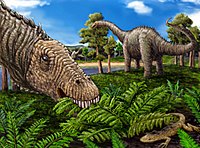
|
| 屬 | 種 | 地區 | 化石材料 | 註解 | 圖片 |
|---|---|---|---|---|---|
| 角爪龍屬 Ceratonykus | 斑點角爪龍 C. oculatus |
賀明察夫地區 | 部分頭骨與其他部位[15][16] | 屬於阿瓦拉慈龍科 | 
|
| 槍蛇爪龍屬 Jaculinykus | 迅捷槍蛇爪龍 J. yaruui |
耐梅蓋特地區 | 近乎完整的鉸接骨骼,包含大部分的顱骨[17] | 屬於阿瓦拉慈龍科小馳龍亞科 | |
| 胡山尾龍屬 Khulsanurus | 美麗胡山尾龍 K. magnificus |
胡山地區 | 部分骨骼,包括頸椎、尾椎、肩胛烏喙骨、肱骨及恥骨[18] | 屬於阿瓦拉慈龍科 | |
| 蛋龍屬 Ondogurvel | 阿氏蛋龍 O. alifanovi |
耐梅蓋特地區 | 部分顱後骨骼,包括胸椎、骶骨、臀部及腿骨[19] | 屬於阿瓦拉慈龍科 | 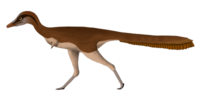
|
| 小馳龍屬 Parvicursor | 遙遠小馳龍 P. remotus |
胡山地區 | 數節脊椎骨、骨盆帶及後肢[20] | 屬於阿瓦拉慈龍科 | 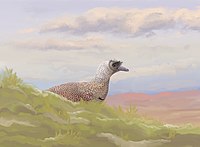
|
| 屬 | 種 | 地區 | 化石材料 | 註解 | 圖片 |
|---|---|---|---|---|---|
| 戈壁蛋屬 Gobioolithus |
大戈壁蛋 G. major |
Gilbent, 胡山地區 | 5枚蛋化石[21] | 可能是由鳥類產下的蛋。 | |
| 小戈壁蛋 G. minor |
賀明察夫地區、胡山地區 | 蛋化石,包含胚胎殘骸[22][21]。 | 也可能是由戈壁雛鳥屬產下的蛋[22][21]。 | ||
| 戈壁雛鳥屬 Gobipipus |
列氏戈壁雛鳥 G. reshetovi |
賀明察夫地區、胡山地區 | 包含顱骨及部分骨骼的胚胎化石[22]。 | 屬於反鳥類。 | |
| 戈壁鳥屬 Gobipteryx |
微小戈壁鳥 G. minuta |
賀明察夫地區、胡山地區 | 顱骨與部分骨骼,以及胚胎遺骸[23][24][25]。 | 屬於反鳥類,同時也發現於德加多克塔組。 | |
| 霍蘭鳥屬 Hollanda |
光亮霍蘭鳥 H. luceria |
賀明察夫地區 | 殘缺的後肢化石[26][27]。 | 屬於今鳥型類。 | 
|
| Protoceratopsidovum | P. fluxuosum | 賀明察夫地區、胡山地區 | 包含19枚蛋的蛋巢化石,及零散的蛋化石[28]。 | 可能是由鳥類產下的蛋[21]。 | |
| P. minimum | Ikh Shunkht | 蛋巢[28]。 | 可能是由鳥類產下的蛋[21]。 | ||
| P. sincerum | 賀明察夫地區 | 蛋化石[28]。 | 可能是由鳥類產下的蛋[21]。 | ||
| Styloolithus | S. sabathi | 胡山地區 | 蛋化石[21]。 | 可能是由鳥類產下的蛋。 |
馳龍科
[編輯]| 屬 | 種 | 地區 | 化石材料 | 註解 | 圖片 |
|---|---|---|---|---|---|
| 作明龍屬 Kuru |
作明佛母龍 K. kulla |
胡山地區 | 零碎骨骼[29]。 | 屬於馳龍科。 | 
|
| 吉祥天母龍屬 Shri |
吉祥天母龍 S. devi |
胡山地區 | 部分關節連接的骨骼,但缺乏顱骨[30]。 | 屬於馳龍科。 | 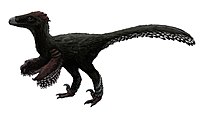
|
| 伶盜龍亞科未定屬 Velociraptorinae indet. |
未定種 Indeterminate |
賀明察夫地區、胡山地區 | 尚未確認[31][32]。 | 屬於馳龍科。 |
哈茲卡盜龍亞科
[編輯]| 屬 | 種 | 地區 | 化石材料 | 註解 | 圖片 |
|---|---|---|---|---|---|
| 胡山足龍屬 Hulsanpes |
珀氏胡山足龍 H. perlei |
胡山地區 | 部分後肢化石及顱骨[33]。 | 屬於哈茲卡盜龍亞科 | 
|
| 泳獵龍屬 Natovenator |
多齒泳獵龍 N. polydontus |
賀明察夫地區 | 部分關節連結的骨骼及顱骨[34]。 | 屬於哈茲卡盜龍亞科 | 
|
傷齒龍科
[編輯]| 屬 | 種 | 地區 | 化石材料 | 註解 | 圖片 |
|---|---|---|---|---|---|
| 沙地龍屬 Harenadraco[35] | 首位沙地龍 H. prima |
賀明察夫地區 | 部分腿、腳及臀部骨骼[35]。 | 屬於傷齒龍科。 | 
|
偷蛋龍類
[編輯]| 屬 | 種 | 地區 | 化石材料 | 註解 | 圖片 |
|---|---|---|---|---|---|
| 竊螺龍屬 Conchoraptor |
纖弱竊螺龍 C. gracilis |
賀明察夫地區、胡山地區 | 多個樣本,包含顱骨與部分骨骼[36][37][38][39][40]。 | 屬於偷蛋龍科,也發現於耐梅蓋特組。 | 
|
| 河源龍屬 Heyuannia |
楊氏河源龍 H. yanshini |
賀明察夫地區 | 部分顱骨及骨骼[41][39][40]。 | 屬於偷蛋龍科,最初被誤認為是雌駝龍屬及機靈龍屬 | 
|
| 耐梅蓋特母龍屬 Nemegtomaia |
巴氏耐梅蓋特母龍 N. barsboldi |
耐梅蓋特地區 | 標本與蛋巢一同被發現[42]。 | 屬於偷蛋龍科,也發現於耐梅蓋特組。 | 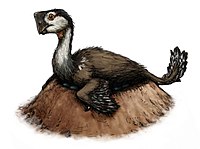
|
圖庫
[編輯]參考文獻
[編輯]- ^ Gradzinski, R.; & Jerzykiewicz, T. (1974). Sedimentation of the Barun Goyot formation. Palaeontologica Polonica, 30, 111-146.
- ^ Carpenter, K., Hayashi, S., Kobayashi, Y., Maryańska, T., Barsbold, R., Sato, K., and Obata, I., 2011, "Saichania chulsanensis (Ornithischia, Ankylosauridae) from the Upper Cretaceous of Mongolia", Palaeontographica, Abteilung A, 294(1-3): 1-61
- ^ 3.0 3.1 3.2 Arbour, V. M.; Currie, P. J.; Badamgarav, D. The ankylosaurid dinosaurs of the Upper Cretaceous Baruungoyot and Nemegt formations of Mongolia. Zoological Journal of the Linnean Society. 2014, 172 (3): 631−652. doi:10.1111/zoj.12185.
- ^ 4.0 4.1 Penkalski, P.; Tumanova, T. The cranial morphology and taxonomic status of Tarchia (Dinosauria: Ankylosauridae) from the Upper Cretaceous of Mongolia. Cretaceous Research. 2017, 70: 117−127. doi:10.1016/j.cretres.2016.10.004.
- ^ Park, J.-Y.; Lee, Y. N.; Currie, P. J.; Ryan, M. J.; Bell, P.; Sissons, R.; Koppelhus, E. B.; Barsbold, R.; Lee, S.; Kim, S.-H. A new ankylosaurid skeleton from the Upper Cretaceous Baruungoyot Formation of Mongolia: its implications for ankylosaurid postcranial evolution. Scientific Reports. 2021, 11 (4101): 4101. PMC 7973727
 . PMID 33737515. doi:10.1038/s41598-021-83568-4
. PMID 33737515. doi:10.1038/s41598-021-83568-4  .
.
- ^ Maryańska, T.; Osmólska, H. Protoceratopsidae (Dinosauria) of Asia (PDF). Palaeontologia Polonica. 1975, 33: 134−143 [2021-05-27]. (原始內容 (PDF)存檔於2018-09-21).
- ^ 7.0 7.1 7.2 Czepiński, Ł. Ontogeny and variation of a protoceratopsid dinosaur Bagaceratops rozhdestvenskyi from the Late Cretaceous of the Gobi Desert (PDF). Historical Biology. 2019, 32 (10): 1394–1421 [2021-05-27]. S2CID 132780322. doi:10.1080/08912963.2019.1593404. (原始內容 (PDF)存檔於2021-07-08).
- ^ Kim, B.; Yun, H.; Lee, Y.-N. The postcranial skeleton of Bagaceratops (Ornithischia: Neoceratopsia) from the Baruungoyot Formation (Upper Cretaceous) in Hermiin Tsav of southwestern Gobi, Mongolia. Journal of the Geological Society of Korea. 2019, 55 (2): 179−190 [2024-03-02]. S2CID 150321203. doi:10.14770/jgsk.2019.55.2.179. (原始內容存檔於2020-05-30).
- ^ Kurzanov, S. M. A new Late Cretaceous protoceratopsid genus from Mongolia. Paleontological Journal. 1990, 24: 85−91.
- ^ Tereschhenko, V. S. Adaptive Features of Protoceratopsids (Ornithischia: Neoceratopsia). Paleontological Journal. 2008, 42 (3): 50−64. S2CID 84366476. doi:10.1134/S003103010803009X.
- ^ Maryańska, T.; Osmólska, H. Pachycephalosauria, a new suborder of ornithischian dinosaurs (PDF). Palaeontologica Polonica. 1974, (30): 45−102 [2024-03-02]. (原始內容存檔 (PDF)於2021-08-31).
- ^ Sullivan, R. M. A taxonomic review of the Pachycephalosauridae (Dinosauria: Ornithischia). New Mexico Museum of Natural History and Science Bulletin. 2006, (35): 347–365.
- ^ K. Mikhailov, K. Sabath, and S. Kurzanov. (1994). Eggs and nests from the Cretaceous of Mongolia. In K. Carpenter, K. F. Hirsch, and J. R. Horner (eds.), Dinosaur Eggs and Babies, Cambridge University Press, Cambridge 88-115.
- ^ Kurzanov, S. and Bannikov, A. (1983). "A new sauropod from the Upper Cretaceous of Mongolia". Paleontologicheskii Zhurnal 2: 90–96.
- ^ Alifanov, V. R.; Barsbold, R. (2009). Ceratonykus oculatus gen. et sp. nov., a new dinosaur (? Theropoda, Alvarezsauria) from the Late Cretaceous of Mongolia. Paleontological Journal 43 (1): 94−106.
- ^ Alifanov, V. R.; Saveliev, S. V. (2011). Brain structure and neurobiology of alvarezsaurians (Dinosauria), exemplified by Ceratonykus oculatus (Parvicursoridae) from the Late Cretaceous of Mongolia. Paleontological Journal. 45 (2), 183−190.
- ^ Kubo, Kohta; Kobayashi, Yoshitsugu; Chinzorig, Tsogtbaatar; Tsogtbaatar, Khishigjav. A new alvarezsaurid dinosaur (Theropoda, Alvarezsauria) from the Upper Cretaceous Baruungoyot Formation of Mongolia provides insights for bird-like sleeping behavior in non-avian dinosaurs. PLOS ONE. 2023-11-15, 18 (11): e0293801. ISSN 1932-6203. PMC 10651048
 . doi:10.1371/journal.pone.0293801
. doi:10.1371/journal.pone.0293801  (英語).
(英語).
- ^ Averianov, Alexander O.; Lopatin, Alexey V. The second taxon of alvarezsaurid theropod dinosaurs from the Late Cretaceous Khulsan locality in Gobi Desert, Mongolia. Historical Biology. 2021-11-18, 34 (11): 2125–2136. ISSN 0891-2963. S2CID 244421277. doi:10.1080/08912963.2021.2000976.
- ^ Alexander O. Averianov; Alexey V. Lopatin. A new alvarezsaurid theropod dinosaur from the Upper Cretaceous of Gobi Desert, Mongolia. Cretaceous Research. 19 February 2022, 134: 105168 [19 February 2022]. S2CID 247000540. doi:10.1016/j.cretres.2022.105168. (原始內容存檔於2022-02-19).
- ^ Karhu, A. A.; Rautian, A. S. (1996). A new family of Maniraptora (Dinosauria: Saurischia) from the Late Cretaceous of Mongolia. Paleontological Journal. 30, 583−592.
- ^ 21.0 21.1 21.2 21.3 21.4 21.5 21.6 Varricchio, D.J.; Barta, D.E. Revisiting Sabath's "Larger Avian Eggs" from the Gobi Cretaceous. Acta Palaeontologica Polonica. 2015, 60 (1): 11–25 [2024-03-02]. (原始內容存檔於2023-11-04).
- ^ 22.0 22.1 22.2 Kurochkin, E. N.; Chatterjee, S.; Mikhailov, K. E. (2013). An embryonic enantiornithine bird and associated eggs from the cretaceous of Mongolia. Paleontol. J. 47, 1252–1269.
- ^ Elzanowski, A. (1977). Skulls of Gobipteryx (Aves) from the Upper Cretaceous of Mongolia. Results of the Polish-Mongolian Paleontological Expeditions - Part VII. Palaeontologica Polonica. 37, 153-165.
- ^ Elzanowski, A. (1995). Cretaceous birds and avian phylogeny. Cour. Forschungsinst. Senckenb. 181, 37-53.
- ^ Kurochkin, E. N. (2004). The truth about Gobipteryx. Sixth International Meeting of the Society of Avian Paleontology and Evolution. Abstracts. 33-34.
- ^ Bell, A.K., Chiappe, L.M., Suzuki, S., Watabe, M. (2008). "Phylogenetic and morphometric analysis of a new ornithuromorph from the Barun Goyot Formation, Southern Mongolia." Abstracts of the 7th International Meeting of the Society of Avian Paleontology and Evolution.1.
- ^ Bell, A.K., Chiappe, L.M., Erickson, G.M., Suzuki, S., Watabe, M., Barsbold, R. and Tsogtbaatar, K. (2010). "Description and ecologic analysis of Hollanda luceria, a Late Cretaceous bird from the Gobi Desert (Mongolia)." Cretaceous Research, 31(1): 16-26. doi:10.1016/j.cretres.2009.09.001
- ^ 28.0 28.1 28.2 Mikhailov, K. E. Theropod and protoceratopsian dinosaur eggs from the Cretaceous of Mongolia and Kazakhstan. Paleontological Journal. 1994, 28 (2): 101−120.
- ^ Napoli, J. G.; Ruebenstahl, A. A.; Bhullar, B.-A. S.; Turner, A. H.; Norell, M. A. A New Dromaeosaurid (Dinosauria: Coelurosauria) from Khulsan, Central Mongolia (PDF). American Museum Novitates. 2021, (3982): 1–47 [2024-03-02]. ISSN 0003-0082. S2CID 243849373. doi:10.1206/3982.1. hdl:2246/7286. (原始內容存檔 (PDF)於2021-11-09).
- ^ Turner, A. H.; Montanari, S.; Norell, M. A. A New Dromaeosaurid from the Late Cretaceous Khulsan Locality of Mongolia (PDF). American Museum Novitates. 2021, (3965): 1−48 [2024-03-02]. ISSN 0003-0082. S2CID 231597229. doi:10.1206/3965.1. hdl:2246/7251
 . (原始內容存檔 (PDF)於2021-01-21).
. (原始內容存檔 (PDF)於2021-01-21).
- ^ Weishampel, D. B.; Barrett, P. M.; Coria, R. A.; Loeuff, J. L.; Xing, X.; Xijin, Z.; Sahni, A.; Gomani, E. M. P. Dinosaur Distribution. Weishampel, D. B.; Dodson, P.; Osmolska, H. (編). The Dinosauria 2nd. University of California Press. 2004: 596−598. ISBN 0520242092.
- ^ Longrich, N. R.; Currie, P. J.; Dong, Z. A new oviraptorid (Dinosauria: Theropoda) from the Upper Cretaceous of Bayan Mandahu, Inner Mongolia. Palaeontology. 2010, 53 (5): 945−960. doi:10.1111/j.1475-4983.2010.00968.x
 .
.
- ^ Cau, A.; Madzia, D. Redescription and affinities of Hulsanpes perlei (Dinosauria, Theropoda) from the Upper Cretaceous of Mongolia. PeerJ. 2018, 6: e4868. PMC 5978397
 . PMID 29868277. doi:10.7717/peerj.4868
. PMID 29868277. doi:10.7717/peerj.4868  .
.
- ^ Lee, Sungjin; Lee, Yuong-Nam; Currie, Philip J.; Sissons, Robin; Park, Jin-Young; Kim, Su-Hwan; Barsbold, Rinchen; Tsogtbaatar, Khishigjav. A non-avian dinosaur with a streamlined body exhibits potential adaptations for swimming. Communications Biology. 2022-12-01, 5 (1): 1185. ISSN 2399-3642. PMC 9715538
 . PMID 36456823. S2CID 254128147. doi:10.1038/s42003-022-04119-9
. PMID 36456823. S2CID 254128147. doi:10.1038/s42003-022-04119-9  (英語).
(英語).
- ^ 35.0 35.1 Lee, S.; Lee, Y.-N.; Park, J.-Y.; Kim, S.-H.; Badamkhatan, Z.; Idersaikhan, D.; Tsogtbaatar, K. The first troodontid (Dinosauria: Theropoda) from the Upper Cretaceous Baruungoyot Formation of Mongolia. Journal of Vertebrate Paleontology. 2024. e2364746. doi:10.1080/02724634.2024.2364746
 .
.
- ^ Maryańska, T.; Osmólska, H.; Wolsan, M. Avialan status for Oviraptorosauria (PDF). Acta Palaeontologica Polonica. 2002, 47 (1): 97−116 [2024-03-02]. (原始內容存檔 (PDF)於2023-08-24).
- ^ Kundrat, M. (2007). Avian-like attributes of a virtual brain model of the oviraptorid theropod Conchoraptor gracilis. Naturwissenschaften. 94: 499−504.
- ^ Kundrat, M.; Janacek, J. (2007). Cranial pneumatization and auditory perceptions of the oviraptorid dinosaur Conchoraptor gracilis (Theropoda, Maniraptora) from the Late Cretaceous of Mongolia. Naturwissenschaften. 94(9): 769−778.
- ^ 39.0 39.1 Funston, G. F.; Mendonca, S. E.; Currie, P. J.; Barsbold, R.; Barsbold, R. Oviraptorosaur anatomy, diversity and ecology in the Nemegt Basin. Palaeogeography, Palaeoclimatology, Palaeoecology. 2018, 494: 101−120. Bibcode:2018PPP...494..101F. doi:10.1016/j.palaeo.2017.10.023.
- ^ 40.0 40.1 Funston, G. F. Chapter 4 – Oviraptoridae (PDF). Anatomy, systematics, and evolution of Oviraptorosauria (Dinosauria, Theropoda) (學位論文). University of Alberta. 2019 [2024-03-02]. (原始內容存檔 (PDF)於2022-10-21).
- ^ Persons, W. S.; Currie, P. J.; Norell, M. A. Oviraptorosaur tail forms and functions. Acta Palaeontologica Polonica. 2014. doi:10.4202/app.2012.0093
 .
.
- ^ Fanti, F.; Currie, P. J.; Badamgarav, D.; Lalueza-Fox, C. New specimens of Nemegtomaia from the Baruungoyot and Nemegt Formations (Late Cretaceous) of Mongolia. PLOS ONE. 2012, 7 (2): e31330. Bibcode:2012PLoSO...731330F. PMC 3275628
 . PMID 22347465. doi:10.1371/journal.pone.0031330
. PMID 22347465. doi:10.1371/journal.pone.0031330  .
.







